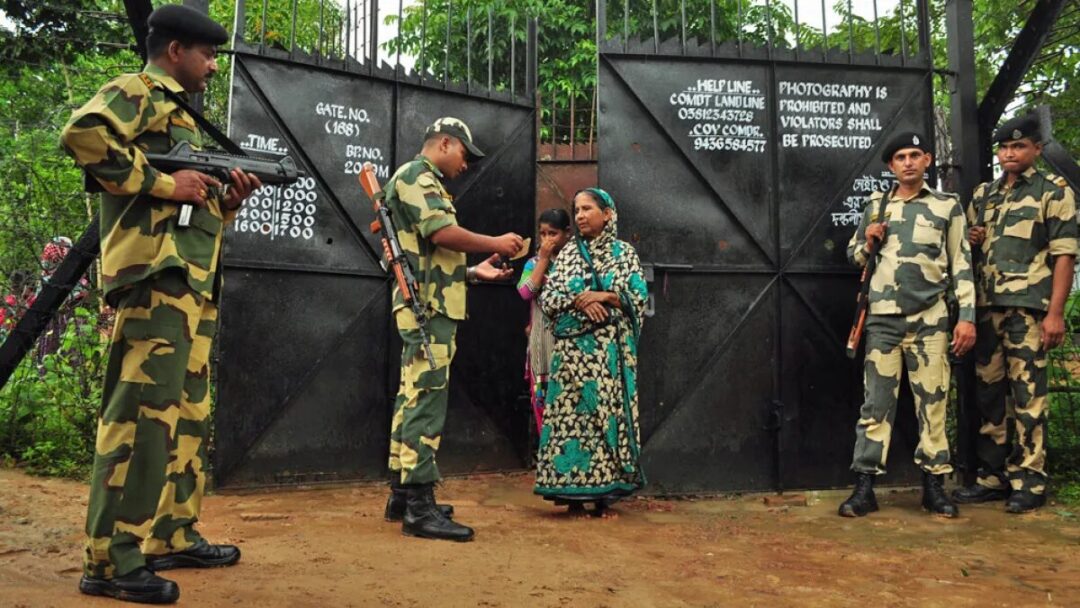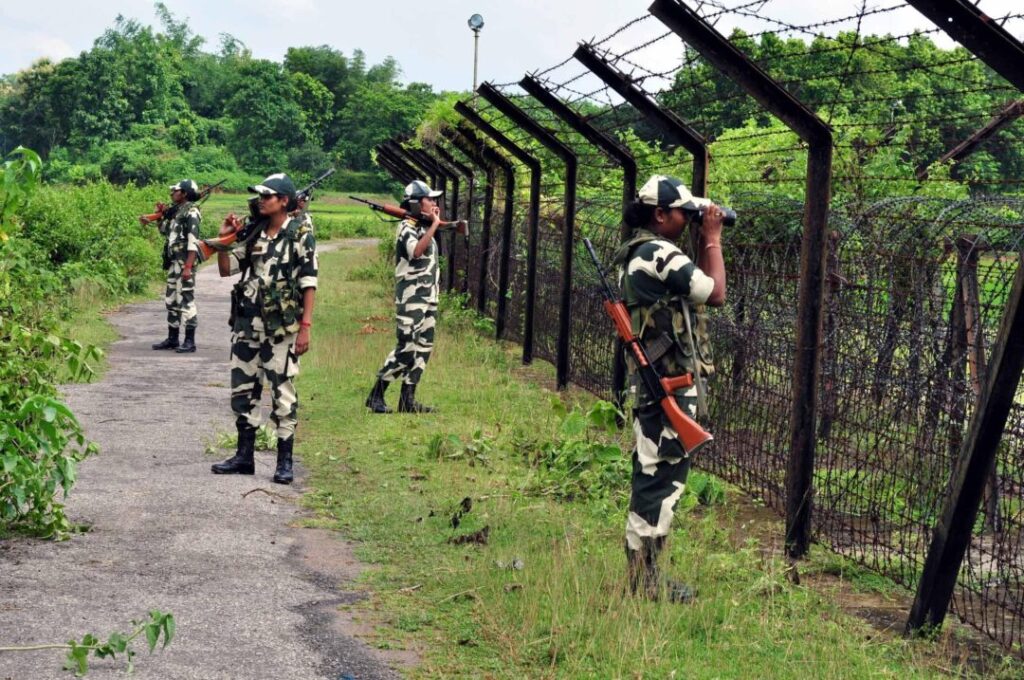Human Security Challenges at the India-Bangladesh Border: An In-Depth Analysis

INDIA-BANGLADESH BORDER: Human Security Challenges
To this day, border regions across the globe continue to be characterized as criminally active hotspots that present especially critical challenges related to security in a human sense. Human security – as defined by the United Nations – consists of freedom from fear and want, with an emphasis on human rights; it views people not just as agents of economic change or members of a social class but deserves respect in their own right. In the case of India- Bangladesh border, there are a number of human security related issues namely illegal migration, trafficking, smuggling and ethno-centric conflicts etc. Drawing from recent studies and reports, this essay provides a comprehensive analysis of these human security issues in the context of India-Bangladesh borders.

THE LANDSCAPE OF HISTORY AND BORDER DYNAMICS
The 4,096 km long India-Bangladesh border is among the most intricate and contentious borders in the world. It came into being in 1947 as a result of partitioning British India (commencing the same day), when members of governance were transferred to dry land by creating Pakistan also known then as West Pakistan, between which will be turned around on across stretching along remote sea border East Bengal region proximity would seem fit. A lot of demographic transitions, cultural crossroads and economic trade across the decades is seen here at this border. But it has also been a location of enduring human security problems, partly because it is porous; due to historical grievances and socio-political dynamics.
THE PHENOMENON OF ILLEGAL MIGRATION AND ITS CONSEQUENCES
Thus, one of the most significant human security threats in the context of India-Bangladesh border are the problems associated with illegal immigration. Since the formation of the new independent country in 1971, there has been a continued immigration of the Bangladeshi people into India mainly in the following areas; political asylum, environmental refugees and economic immigrants from Bangladesh. Chari (2015) avers in a report by the Institute for Defence Studies and Analyses (IDSA): the magnitude of illegal migration therefore has a bearing on both the host as well as the source countries.

Migrants pour into India and lead to strain in the competition with the locals in the aspect of jobs, resources, and services thus fuelling social vices and struggle. This creates vulnerability of the migrants since their human security is breached by way of exploitation, the legal framework fails to protect them, and the living conditions are wanting. With regard to the matter of illegal migration, political dynamics have played out between India and Bangladesh, which has resulted in curtailment of border liberties by India, which is a violation of human rights.
(Read More: India needs a strategic approach to hybrid warfare)
TRAFFICKING AND SMUGGLING
Slavery and drug trafficking are common along the northern borders of India especially along the border with Bangladesh; this is dangerous to human security. Women and children can be easily affected and some of the consequences include but not limited to forced labour, forced prostitution, and domestic servants. The UN Office on Drugs and Crime has revealed South Asian region fundamentalists, especially, India-Bangladesh borders to be strategic channels for human trafficking (UNODC 2020).
Another important problem is smuggling: meat, including cattle, narcotics, and arms. Such activities erode economic security as well as contribute to criminal organizations and violence, which threatens human security in the area. However, due to the open and permeable border and the acts of complicity of local criminal organisations and bureaucracy, the fight against trafficking and smuggling is a challenge.
ETHNIC CONFLICTS AND DISPLACEMENT
Ethnic conflicts and population displacement are also among the human security threats along the border of the two countries of India and Bangladesh. The area has a large population of ethnic groups with political scores to settle and fancy for their piece of land. For instance, the indigenous peoples of the Chittagong Hill Tracts in Bangladesh and the neighbouring areas of India have long-standing ethnic conflicts, which in turn lead to the forced displacement and different forms of abuses of human rights (Chakma, 2018).
(Read more: Human Security Issues in Border Regions: Challenges and Solutions)
Such crises often lead to forced displacements implying the uprooting of nations/communities, thus, causing humanitarian issues. This has affected the displaced population adversely in areas to do with shelter, food Security, health, and education thereby increasing their vulnerabilities hence their insecurity.
ENVIRONMENTAL CHALLENGES
The major environmental concerns which impact human security are riverbank erosion, floods and climate change resultant displacements within the border of India and Bangladesh. Hazardous climate-related events that afflict both the countries include flooding and river bank erosion in the shared Ganges, Brahmaputra- Meghna basins; yearly many thousands of peoples are displaced.
The problem of the environment has been worsened by climate change, since besides fluctuations of sea level in non-border regions, extreme or frequent unpredictable diseases affect the lives of bordering inhabitants. The affected populations move to other areas looking for relatives, jobs, and other necessities hence an addition of pressure to urban areas and more issues on human security.
BORDERS: MANAGEMENT OR HUMAN RIGHTS?
The authorities’ actions to control borders influence people’s security in the region. The BSF of India has been alleged for using undue force say, firing at the unarmed civilians, which resulted in several deaths and causalities. The situation along the border has been documented by Human Rights Watch (HRW) reporting that abuses continue to take place, saying that the situation requires much attention to international standards in human rights (Human Rights Watch, 2010).
The duty of refining borders in line with the objectives of safeguarding its people whilst at the same time respecting human dignity cannot be overemphasized. These problems can be handled with ease through improved cooperation between India and Bangladesh, raising the architectural engineering of the borders and through CBM approach.
POLICY RECOMMENDATIONS AND CONCLUSION
Therefore, the complex problem of human security issues in this case for the inhabitants residing at the border region of India and Bangladesh calls for a multi-dimensional partnership between the two countries as well as the international community. Key policy recommendations include:
Strengthening Bilateral Cooperation: If the Indian and Bangladeshi governments step up their cooperation in border security, vigilance, and patrols the threats of cross-border migration, trafficking, and smuggling can be more efficiently contained.
Protecting Human Rights: Championing for Human Security: Legal and Protective Support for Border Security Forces’ Responsibility for Human Rights Abuses while Offering Legal Assistance to High-Risk Groups.
Addressing Root Causes of Migration: They reasoned that the border country’s economic growth and establishment, as well as the provision of sustainable livelihood in the border areas, will decrease the pull factors for the subjects to engage in the practice of illegal migration.
Enhancing Community Engagement: Engaging the people of the communities at the borders in the activities relating to border security and management and borders development, brings about harmony and less conflicts hence promoting human security.
Climate Adaptation and Disaster Management: This paper also notes that there is the possibility of developing effective climate changes adaptation measures and sound disaster management systems means that the impact of these disorders in the bordering areas can be limited.
International Support: Thus, the international organizations can be involved in supporting the states and using the international frameworks concerning migration, human trafficking, and human rights.
Thus, the India-Bangladesh border is a case of diverse human security threats emerging from border zones across the world. Solving such problems demands a multifaceted strategy based on the principles of human rights, bilateral relations, and sustainable development paradigms. In this way, promoting the welfare of communities on both sides of the border, India and Bangladesh can improve their population’s safety and well-being and thus contribute to the general stability of the region.
References
- Chari, P. R. (2015). Illegal Migration from Bangladesh: Deportation, Borders, and Nationals. Institute for Defence Studies and Analyses.
- Chakma, B. (2018). The Chittagong Hill Tracts Conflict: An Analysis. Asian Survey, 58(1), 68-91.
- Rahman, M. M. (2019). Environmental Challenges and Human Security in the Ganges-Brahmaputra-Meghna Basin. Journal of Environmental Management, 233, 1-11.
- Human Rights Watch. (2010). Trigger Happy: Excessive Use of Force by Indian Troops at the Bangladesh Border. Human Rights Watch.
- UNODC. (2020). Trafficking in Persons in South Asia: A Regional Overview. United Nations Office on Drugs and Crime.
- Institute for Defence Studies and Analyses (IDSA). (2015). Illegal Migration from Bangladesh: Deportation, Borders, and Nationals. Institute for Defence Studies and Analyses.



Leave a Reply